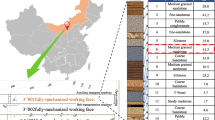Abstract
Salt-gypsum rock in Eastern Sichuan Basin is widely developed; however, the creep and dissolution of salt-gypsum rock easily lead to reduced diameter or enlargement of wellbore during drilling process. This phenomenon seriously hinders the safety and efficiency of oil and gas development. In this paper, based on the dissolution test of salt-gypsum rock under the water-based drilling fluid, the salt-gypsum rock dissolution law with the effects of chloride ion concentration and temperature is studied explicitly. By incorporating the creep and dissolution effects of the salt-gypsum rock under drilling fluid, the plate of diameter reduction curve for the salt-gypsum formation is established, and the effects of the Chloride ion concentration and temperature on the reduction rate of wellbore diameter are analyzed. This research demonstrates that, under the dual actions of salt-gypsum rock dissolution and creep, as the chloride ion concentration becomes smaller and the formation temperature is lower, the diameter reduction of salt-gypsum formation turns out to be smaller. In the meanwhile, the safe drilling fluid density can be effectively reduced by optimizing the chloride ion concentration to achieve the low-density drilling, especially for the formation with lower temperature. Furthermore, a novel approach for the design of drilling fluid density in salt-gypsum formation is put forward, which provides a necessary and reliable reference for drilling operation.






Similar content being viewed by others
References
Agergaard AF (2010) Modelling of rock salt creep. Technical University of Denmark Kgs Lyngby Denmark
Bérest P, Béraud JF, Gharbi H, Brouard B, Devries K (2015) A very slow creep test on an Avery Island salt sample. Rock Mech Rock Eng 48(6):2591–2602
Botelho FV (2008) Numerical analysis of mechanical behavior of the salt in oil wells. M.Sc. Thesis - Department of Civil Engineering, Pontifical Catholic University of Rio de Janeiro (PUC-Rio).
Carter NL, Hansen FD (1983) Creep of rocksalt. Tectonophysics. 92(4):275–333
Dusseault MB, Maury V, Sanfilippo F, Santarelli FJ (2004) Drilling through salt: constitutive behavior and drilling strategies. Paper ARMA/NARMS 04-608 presented at the 6th North America Rock Mechanics Symposium (NARMS), Houston, Texas, June 5-9.
Fjær E, Holt RM, Horsrud P, Raaen AM, Risnes R (2008) Petroleum related rock mechanics, 2nd edn. Elsevier, Amsterdam
Günther RM, Salzer K, Popp T, Lüdeling C (2015) Steady-state creep of rock salt: improved approaches for lab determination and modelling. Rock Mech Rock Eng 48(6):2603–2613
Hampel A, Hunsche U, Weidinger P, Blum W (1998) Description of the creep rock salt with the composite model-II steady-state creep. Series on Rock & Soil Mechanics.
Jin ZJ, Long SX, Zhou Y (2006) A study on the distribution of saline-deposit southern China. Oil Gas Geol 27(5):571–583
Li P, Deng JG, Sun Y, Yan XJ, Xu XG (2012) Experimental study of creep characteristics of rock gypsum-salt and rock salt in Chuandong gas field. Rock Soil Mech 33(2):444–448
Li S, Kang YL, You L, Lian Z (2014) Experimental and numerical investigation of multiscale fracture deformation in fractured-vuggy carbonate reservoirs. Arab J Sci Eng 39(5):4241–4249
Lin LB, Hao Q, Yu Y, Dan Y, Peng YM (2014) Development characteristics and sealing effectiveness of Lower Cambrian gypsum rock in Sichuan Basin. Acta Petrol Sin 30(3):18–726
Liu HX, Li FD, Liu SJ (2000) Effect of gypsum-salt bed on casing in Sichuan area. Drill Prod Technol 23(3):26–28
Qin D, Xiong J, Wang G (2018) A novel hydraulic tool for lost circulation control while drilling with improved plugging effectiveness. Arab J Sci Eng 43(5):1–12
Rahimi S, Hosseini M (2015) Laboratory studies of creep behavior on thick-walled hollow cylindrical salt rock specimens. Arab J Geosci 8(8):1–9
Schubert R, Tompkins H (2003) Effects of exposure to vapors of saturated salt aqueous solutions. IEEE-TCHMT. 5(4):425–430
Weidinger P, Hampel A, Blum W, Hunsche U (1996) Creep behaviour of natural rock salt and its description with the composite model. Mater Sci Eng A 236(97):646–648
York P, Pritchard D, Dodson JK, Rosenberg S, Gala D, Utama B (2009) Eliminating non-productive time associated with drilling trouble zones. Paper OTC 20220, presented at the Offshore Technology Conference, Houston, Texas, USA, 4-7 May
Funding
This work received financial support from the Key Program of National Natural Science Foundation of China (U1762211) and Major Science and Technology Program of China National Petroleum Corporation (2016E-0608).
Author information
Authors and Affiliations
Corresponding author
Additional information
Responsible Editor: Abdullah M. Al-Amri
Rights and permissions
About this article
Cite this article
Zhao, C., Li, J., Liu, G. et al. Analysis of wellbore diameter variation in salt-gypsum formation with the effect of drilling fluid. Arab J Geosci 12, 608 (2019). https://doi.org/10.1007/s12517-019-4782-5
Received:
Accepted:
Published:
DOI: https://doi.org/10.1007/s12517-019-4782-5




